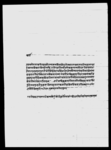An arjī from Raṇadala Pā̃ḍe re the capturing of elephants (VS 1894)
ID: DNA_0001_0005
Edited and
translated by Axel Michaels, Manik Bajracharya and Rajan Khatiwoda
in collaboration with
Philip Pierce
Created: 2014-12-04;
Last modified: 2020-10-25
For the metadata of the document, click here
The accompanying edition, translation/synopsis and/or commentary are available under the terms of the Creative Commons Attribution-ShareAlike 4.0 International License
Abstract
Raṇadala Pā̃ḍe writes this letter to the authority concerned in respect of offering an elephant named Raṇa Prakāśā from Citavana, Nepal.Diplomatic edition
[1r]
1अर्जि¯ ¯ ¯ ¯ ¯ ¯ ¯ ¯ ¯ ¯ ¯ ¯ ¯ ¯ ¯ ¯ ¯ ¯ ¯ ¯ ¯ ¯ ¯ ¯ ¯ ¯ ¯ ¯ ¯ ¯ ¯ ¯ ¯ ¯ ¯ ¯2उप्रान्त•येस्पटकचितवन्कोतप्पामा•पक्रियाकोठुलोमत्ता•रणप्रकासहाति१हजुरमाचर्हा
3ईपठायाकोछदाषिलहोला•हैदरवेग्हाति•सधैउस्तोकाम्लाग्न्याहोइन•येस्पालादा
4रोगाराउत्माहुत्हरूलेधेरैमिहिनेत्गर्दा•हैदरवेग्लेपक्र्यो•पाल्पाहातिसारकोनांज्या
5दामुल्हाति•हातिषेदामासधैकाम्लाग्न्या•सवारिमाफिक्काहातिहरुपक्रन्याअडंग
6वाहादुरहातिहो•ञाहाकोहातिसारमाअडंगवाहादूरहातिपनिपठाइवक्सनुभयाञाँहा
7कोहातिसारवेस्गरीजम्न्या[...][...]वारिमाफिक्काहातिहरूपनिपक्रिहजूरमादाषिल
8हुँदैरहदाहुन्•जोहुकुम्•विज्ञप्रभुचरणकमलेषुकिमधिकम्इतिसम्वत्१८९४सा
9लमितिचैत्रशुदि१५रोज२मुकाम्तानसेन्शुभम्¯ ¯ ¯ ¯ ¯ ¯ ¯ ¯ ¯ ¯ ¯ ¯ ¯ ¯ ¯
10सदासेवकस्यरणदलपाँडेकस्यकोटिकोटिकुर्नेससाष्टांगदंडवत्सेवासेवासेवासहस्रम्शुभम्
Translation
[1r]
Arjī –
[Regarding the] following: This time a big ruttish (mattā)1 elephant captured in an area of Citavana [and given the name] Raṇa Prakāśa has been sent to you. [Hopefully], it will have reached you. The elephant [named] Haidaraveg is not always so useful. This time, thanks to the hard labour of the elephant stable manager (dārogā)2 , head of the elephant care team (rāut)3 and elephant riders (māhut), Haidaraveg caught [Raṇa Prakāśa]. The popular chief elephant Aḍaṅga Bahādura from the elephant stable (hātisāra) in Pālpā is the one who is always useful for elephant hunts,4 and catches elephants best suited for your outings. The elephant stable here would [therefore] be much better, if you could also send the elephant Aḍaṅga Bahādura. Once elephants suited for outings are caught, they would be continously turned over to you. [We will do] as you order. What more [to say] to our learned lord whose feet are lotuses!
Monday, the 15th of the bright fortnight of Caitra in the [Vikrama] era 1894 from the Tānasen residence. [Let it be] auspicious.
Tens of millions of eightfold salutations5 from [your] always [faithful] servant Raṇadala Pā̃ḍe, at [your] service. Three times reverence. [Let it be] thousandfold auspicious.
Commentary
Most documents on elephants deal with elephants used for hunting and riding for kings and nobility. They are regarded as a prized symbol of status and, due to their association with Gaṇeśa, of power combined with auspicious qualities. This became last evident in 1975 when King Vīrendra and Queen Aiśvaryā undertook their coronation proccession on the back of an elephant. The Śāhas and Rāṇās were famous for organizing hunts which could last several weeks and involve hundreds of elephants (Locke 2006: 11). Jaṅga Bahādura Rāṇā’s fondness for elephants and his courage in dealing with them is well-known.
Elephants were important for the economy and lucrative trading commodity (Regmi 1984: 198-199). They were also used in war and in controlling the borders, as is clear from a lālamohara issued by King Gīrvāṇayuddha dated Mārga sudi 1, VS 1867, to all officials where elephant stables had been established and in which the dārogās, rāutas, māhutas etc. are told: “In case you vacate a single inch of the territory under our occupation, you shall be held to have committed a serious crime” (Regmi 1972: 46 referring to RRC, vol. 38, p. 645).

